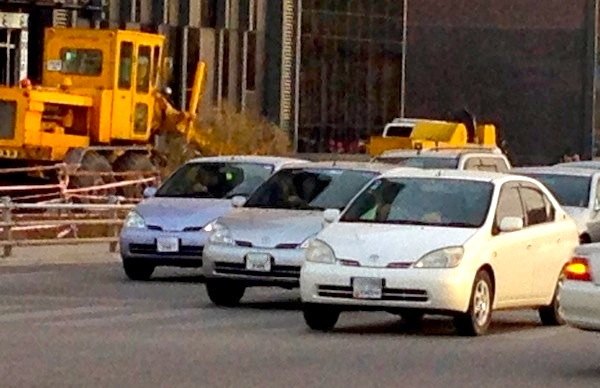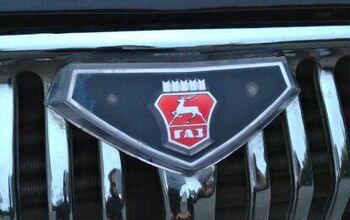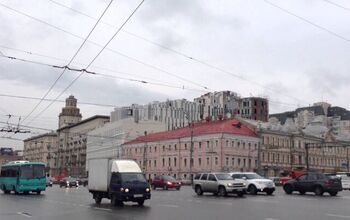Best Selling Cars Around The Globe: Trans Siberian Series Part 11: Mongolian First Impressions
Three first generation Toyota Prius at a traffic light: a common sight in Ulaanbaatar…
We now continue on our Trans-Siberian railway adventure and after going through Siberia and crossing the Lake Baikal up to Ulan Ude in Buryatia, we are now travelling South to Mongolia. In this post I will describe my first impressions about the unique Mongolian car landscape, but we will start with a bit of introduction on Mongolia as a country, because knowing overall facts about this country goes a long way in explaining its car park.
If you can’t wait for the next report, you can follow my trip in real time here, or check out 174 other car markets on my blog.
Mongolia is the least densely populated country in the world with just 2.9 million inhabitants on 1.6 million square km, or 1.8 inhabitant per square km. Around half of the country’s total population lives in Ulaanbaatar, the world’s coldest capital city with an annual average temperature of 0°C (32°F) and January averages dropping as low as -30°C (−22°F). This means outside of Ulaanbaatar we are looking at less than one inhabitant per square km. Mongolia is landlocked between Russia (50 times more populated) and China (450 times more populated)…
In spite of its sparse population and challenging climate, Mongolia was the fastest-growing economy in the world in 2012, with a GDP up 12%. This growth will be sustained – if not improved – by this year’s opening of the $5 billion Oyu Tolgoi copper and gold mine in the Gobi desert in South-Eastern Mongolia, expected to single-handedly account for one-third of the country’s GDP by 2020! Today in Mongolia about 20% of the population still lives on less than US$1.25 a day.
95% of Mongolians (citizens of Mongolia) belong to the Mongol ethnicity, originally claimed by Genghis Khan in 1206 when he founded the Mongol Empire. More than half of the people not living in Ulaanbaatar are still nomadic or semi-nomadic, with Shamanism and the belief in maintaining a balance with nature (not digging holes or tearing up the land) very much alive, along with Tibetan Buddhism which is the predominant religion in the country. As such the Oyu Tolgoi mine is inexcusable according to shamans, and may lead to retribution from the sky gods.
Mongolia’s turbulent political history in the last century is probably the most important element to be aware of in order to understand the composition of the car landscape today. In 1911 Mongolia declared its independence from China, but then came under Soviet influence from 1924 onwards. After being refused entry in the United Nations by the USA and China in 1945, Mongolia was eventually recognised by the UN as an independent country in 1961, but the USSR continued to occupy it with troops and run it as a satellite state until 1990, when the first democratic elections were held. Despite leaving a seven decade-long communism heritage behind only 20 years ago, Mongolia is often held up as a model emerging democratic state, which is nothing short of a miracle based on its geopolitical situation.
Now we all know a bit more about the country, on to the car landscape. And as soon as I crossed the border, the contrast with Russia was striking. Used Hyundai Excel and Ponys were everywhere, and no Ladas in sight! The country’s history has indeed had a massive impact on today’s Mongolian car landscape. There are virtually no Russian nor Chinese passenger cars in Mongolia! I only saw one GAZ Volga and one Chery QQ6, both spotted in Ulaanbaatar. Commercial vehicles are a bit different: the UAZ Bukhanka and Hunter are relatively common as overland 4WDs, and most of the infrastructure work I saw is catered for by Chinese heavy trucks.
As we drove closer and closer to Ulaanbaatar, a totally new element came to light: the unbelievable frequency of the first two generations Toyota Prius as used right-hand drive Japanese imports. This is even more blatant in the capital, and I saw more first generation Prius in the first 20 minutes I spent in Ulaanbaatar than I did in my entire life before that! Sitting at a busy intersection for no more than 8 minutes, I counted 69 first generation Prius and 75 second generations, making Mongolia the country in the world with the highest penetration of Toyota Prius in its car landscape! Basically if you are a Toyota Prius and you behaved in Japan, you earn yourself a second life in Mongolia…
There’s a simple explanation to this madness: there is no import tax on used hybrid vehicles in Mongolia, and it’s forbidden to import a vehicle aged over 9 years. The equation is simple: the cheapest car to import into Mongolia today is a 2004, 2nd generation Toyota Prius which will see its share of the Mongolian car landscape increase further over the next few years to the detriment of the 1997-2003 first generation which is technically impossible to import anymore. Remember how Mongolians believe in maintaining a balance with nature? Not taxing hybrid imports is one very effective way to follow this belief, and compensate a tiny bit for the Oyu Tolgoi mine…
Below the first two generation Prius, the other successful used Japanese imports will be familiar to those who have read my are earlier Trans-Siberian Photo Reports: the Toyota Ist, Probox and the rear-drive Verossa are the most frequent. It looks like every single Verossa sold during its short-lived Japanese career (2001-2004) is now finishing its days in Mongolia, with many more of them in the capital city than I saw in the whole of Russia. There are a few newcomers to the used aisle though: the Toyota Mark II Grande, Mark X and current gen Crown hybrid are also extremely popular here.
All this is good and well, but where are the new cars? My estimation of the Mongolian new car market before this report, based on YouTube videos, placed the Hyundai Accent and Sonata atop the sales charts. My first observations squash this estimate, as the Toyota Land Cruiser looks like the most popular new car in Ulaanbaatar and therefore the country, with its (even more) luxurious counterpart the Lexus LX following close behind.
Wot? Yep. Mongolians have embraced consumerism whole-heartedly and in a very limited car market – 45,000 units (used and new) predicted in 2013 – if you have enough money to buy a brand new vehicle, you preferably buy a big, badass one. Like a Nissan Patrol, Infiniti QX or… Hummer, extremely frequent in Ulaanbaatar! I will write more on this subject in one of my next Mongolian Photo Reports.
The Hyundai Sonata is by far the most popular Hyundai here, with the last four generations of the model all equally well represented on Mongolian roads, and the current gen should be on the podium in 2013 whereas the Elantra and Accent are much less successful as new models. A special mention to the Hyundai ix35 and Kia Sportage, I saw a lot of them in the streets and they should find their way into the 2013 Top 5.
That’s it for the introduction to Mongolia and my first impressions on the country’s fascinating car landscape, next we will stop in Terelj National Park, 80km East of Ulaanbaatar, the opportunity to test out sleeping in a traditional ger and verify the 13 to 1 horse-to-human ratio Mongolia so proudly advertises…
Source of the Mongolian background facts: Wikipedia and Lonely Planet Mongolia, 2011 edition.
More by Matt Gasnier
Latest Car Reviews
Read moreLatest Product Reviews
Read moreRecent Comments
- ToolGuy First picture: I realize that opinions vary on the height of modern trucks, but that entry door on the building is 80 inches tall and hits just below the headlights. Does anyone really believe this is reasonable?Second picture: I do not believe that is a good parking spot to be able to access the bed storage. More specifically, how do you plan to unload topsoil with the truck parked like that? Maybe you kids are taller than me.
- ToolGuy The other day I attempted to check the engine oil in one of my old embarrassing vehicles and I guess the red shop towel I used wasn't genuine Snap-on (lots of counterfeits floating around) plus my driveway isn't completely level and long story short, the engine seized 3 minutes later.No more used cars for me, and nothing but dealer service from here on in (the journalists were right).
- Doughboy Wow, Merc knocks it out of the park with their naming convention… again. /s
- Doughboy I’ve seen car bras before, but never car beards. ZZ Top would be proud.
- Bkojote Allright, actual person who knows trucks here, the article gets it a bit wrong.First off, the Maverick is not at all comparable to a Tacoma just because they're both Hybrids. Or lemme be blunt, the butch-est non-hybrid Maverick Tremor is suitable for 2/10 difficulty trails, a Trailhunter is for about 5/10 or maybe 6/10, just about the upper end of any stock vehicle you're buying from the factory. Aside from a Sasquatch Bronco or Rubicon Jeep Wrangler you're looking at something you're towing back if you want more capability (or perhaps something you /wish/ you were towing back.)Now, where the real world difference should play out is on the trail, where a lot of low speed crawling usually saps efficiency, especially when loaded to the gills. Real world MPG from a 4Runner is about 12-13mpg, So if this loaded-with-overlander-catalog Trailhunter is still pulling in the 20's - or even 18-19, that's a massive improvement.

















































Comments
Join the conversation
I should visit here. Completely off the radar. Since i don't hear about them in the news, and the Russians aren't invading them. They must be doing something right.
"God damm Mongorians!" But seriously, how angry are you going to make other drivers and citizens when you roll up in your $90,000USD imported luxury SUV and they're living on $1.25 a day? That's $456.25/year, which means they could afford your car in 197 years. Also the Verossa is utterly hideous, and I never want to see one again. It's like some awful Lancia Ypsilon impression.